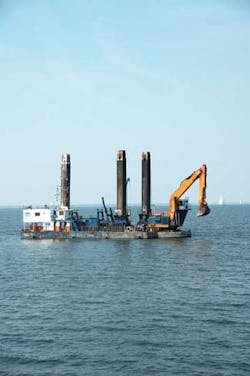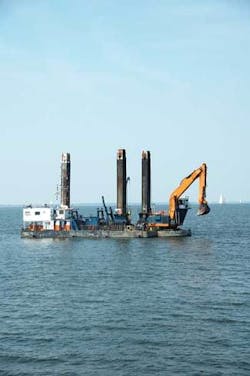Van Oord opens gas transport channel across the IJsselmeer
Genarda Brinkers, Van Oord
Dutch gas production company Gasunie is building a new gas transport pipeline between the Frisian cities of Workum and Wieringermeer in the province of North Holland. The pipeline is required as the western part of the Netherlands has been suffering a gas shortage because gas reserves in the North Sea have decreased and the two existing pipelines offer insufficient capacity. The shortage of gas in west Netherlands has worsened because of exports in recent years to the United Kingdom.
Also, increasing international gas trade demands a new pipeline connection between the Dutch/German border in the east of the Netherlands stretching all the way to the Dutch west coast, and on to the United Kingdom. The subsea pipeline under the IJsselmeer - the body of water separating the northwest of The Netherlands from the rest of the country - will be part of the priority pipeline system being built by the European Union.
The NACAP/Van Oord joint venture won the €30 million-plus construction contract at the beginning of 2006. It involves installation of a 48-in. gas pipeline between Medemblik (part of the Wieringermeer municipality) and Workum, over a distance of some 36 km. Approximately 28 km of the distance will be through the IJsselmeer. NACAP is responsible for the overland lines, welding of the pipeline joints, and the installations; Van Oord has responsibility for the ‘wet’ part of the work.
Work began at the end of May, after all necessary permits were granted. This proved to be quite a job in itself as environmental legislation stipulates that this project required no less than 112 work permits - most pertaining to temporary provisions needed to protect the environment of the IJsselmeer during the campaign. Van Oord started by excavating a trench from the cofferdam in Medemblik through the IJsselmeer. Two crane pontoons dredged a 4-m wide trench around 2.2 m deep.
At the same time, the company’s joint venture partner was welding 12-m lengths of pipeline at a work port to construct 500-m long strings. These pipes will be towed from the work port to the trench by a convoy of workboats. As each 1 km of the trench is excavated, two pontoons are used to couple two pieces of pipeline. Air filled steel tanks 1.40 m in diameter keep the pipeline afloat. When they are undone one by one, the pipeline sinks to the bottom of the trench. Van Oord is deploying around 10 pontoons, workboats, and multicats to sink the pipeline.
Dredging continues, with the dredged material re-used immediately to cover the newly installed pipeline section. The work area in which the pipeline is sunk and covered, measures about 1,500 m long and 200 m wide. It is marked by buoys to guarantee shipping traffic safe passage as the work area moves across the IJsselmeer. Ultimately, the pipeline will be buried approximately 60 cu m beneath the lake bed. In the shipping channel, it will be buried to a depth of about 1.5 m. The pipeline ‘grows’ roughly 500 m each day. Van Oord expects to complete the work by August.
Sinking pipelines in such shallow water requires exceptional skill by the contractor. Waves, especially, can complicate the work. Van Oord’s Offshore business unit supplies the expertise in the field of sinking and burying pipelines, while the company’s Netherland business unit supplies the know-how and experience in the fields of environmental dredging and permits.
The work has been carried out during the summer months. This was a deliberate choice by the client, because the IJsselmeer, although its name contains the Dutch word for lake, often behaves like a sea, and during fall and winter, the weather can be very bad. If all goes according to plan, Gasunie will be able to bring an important new connection to its pipeline network into operation by December 2006.


